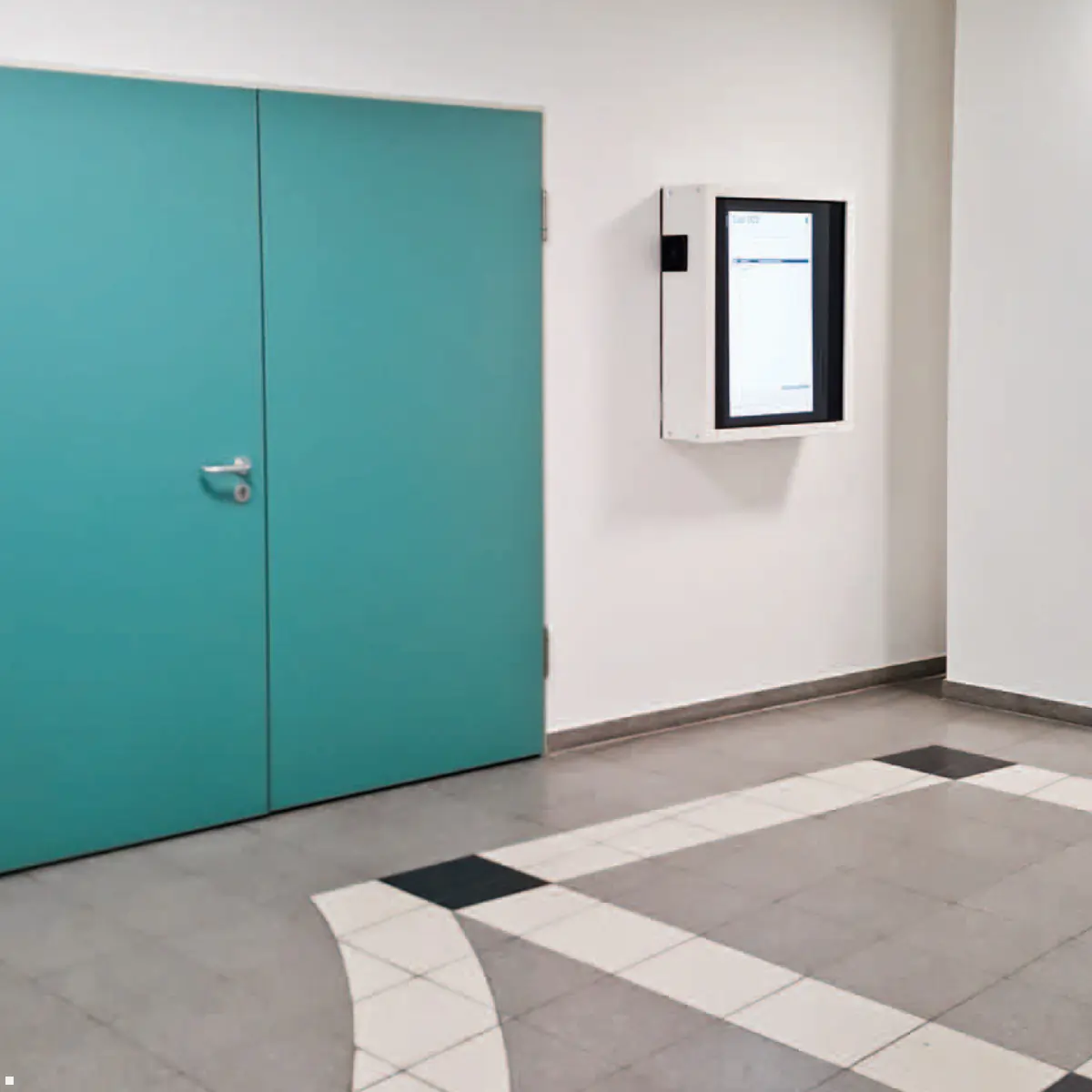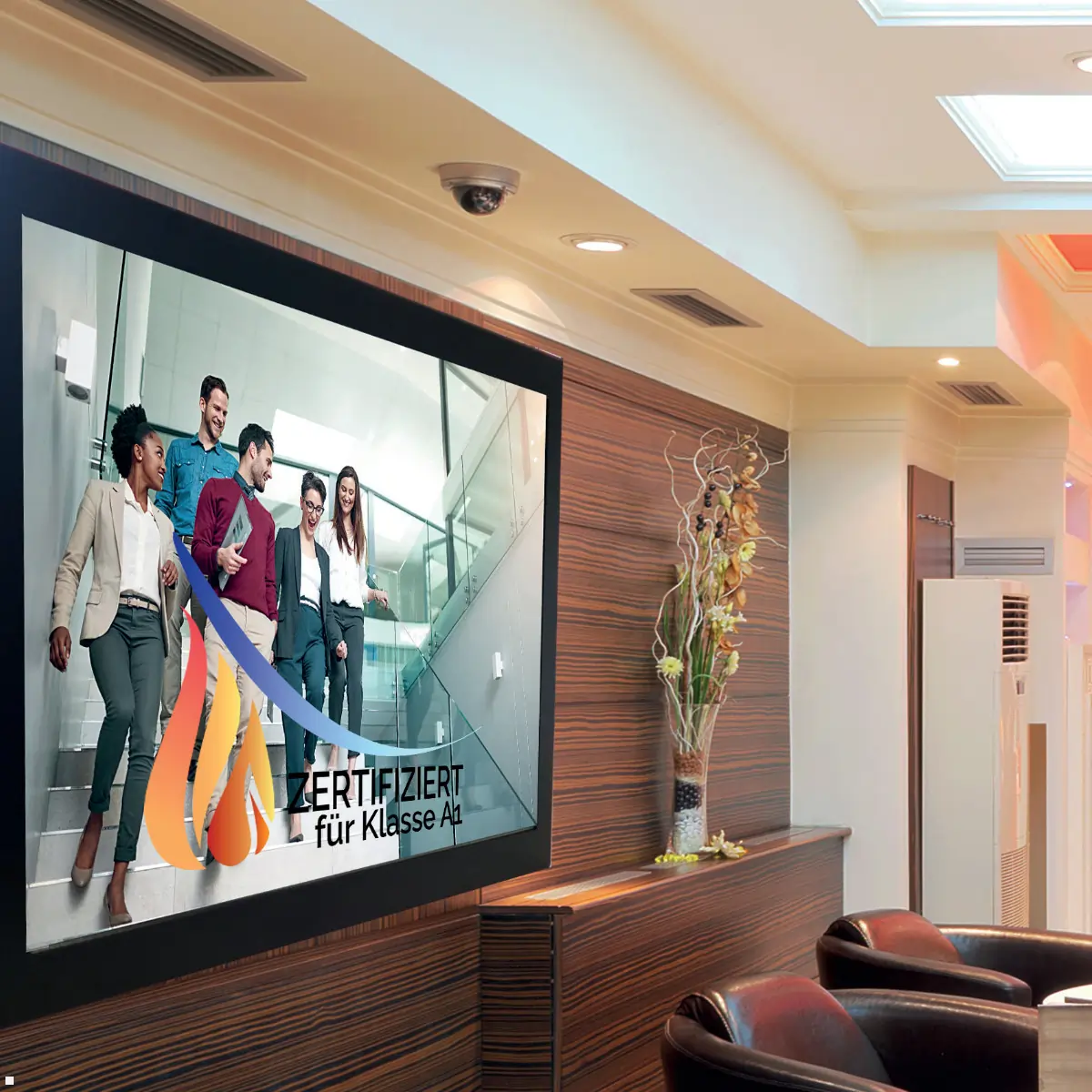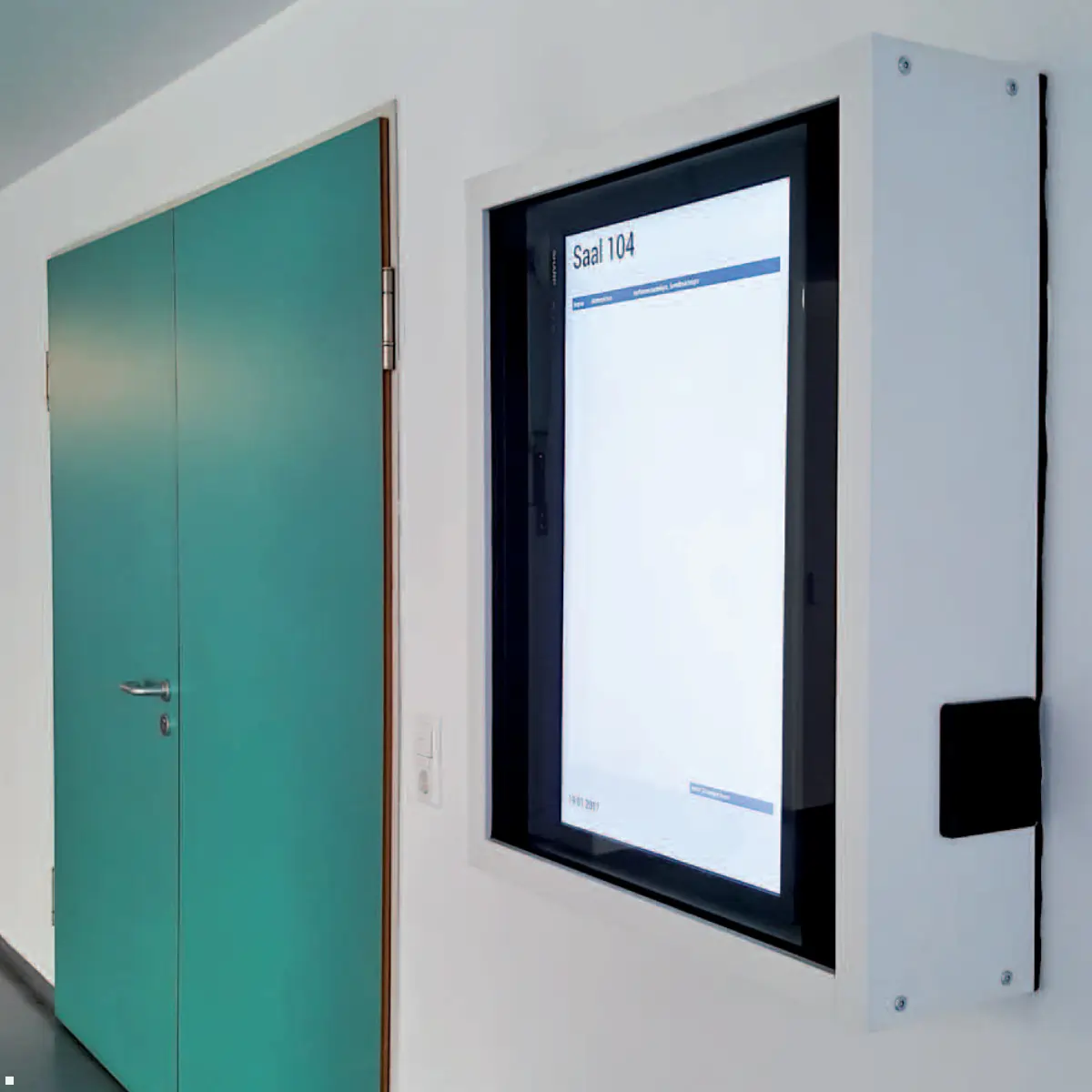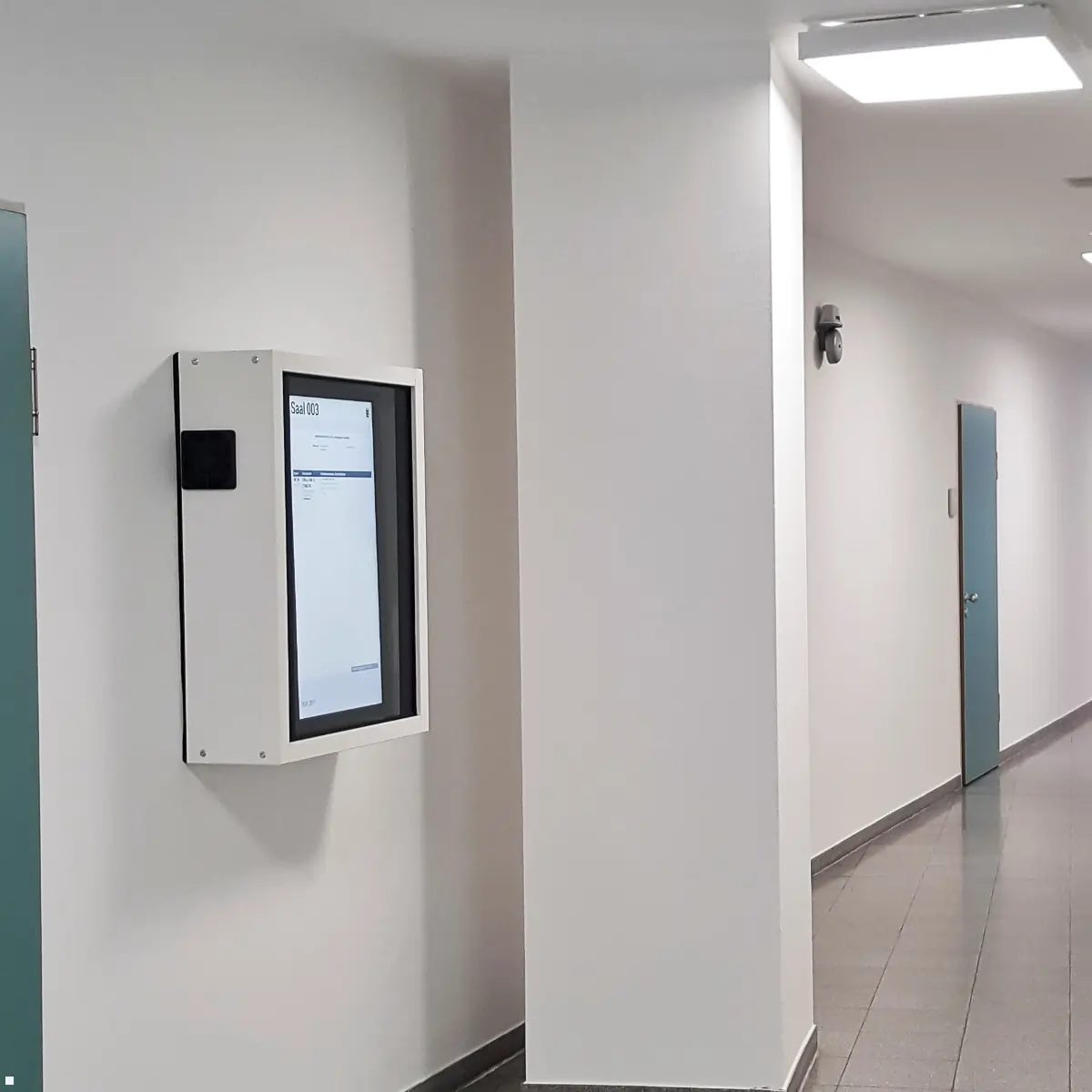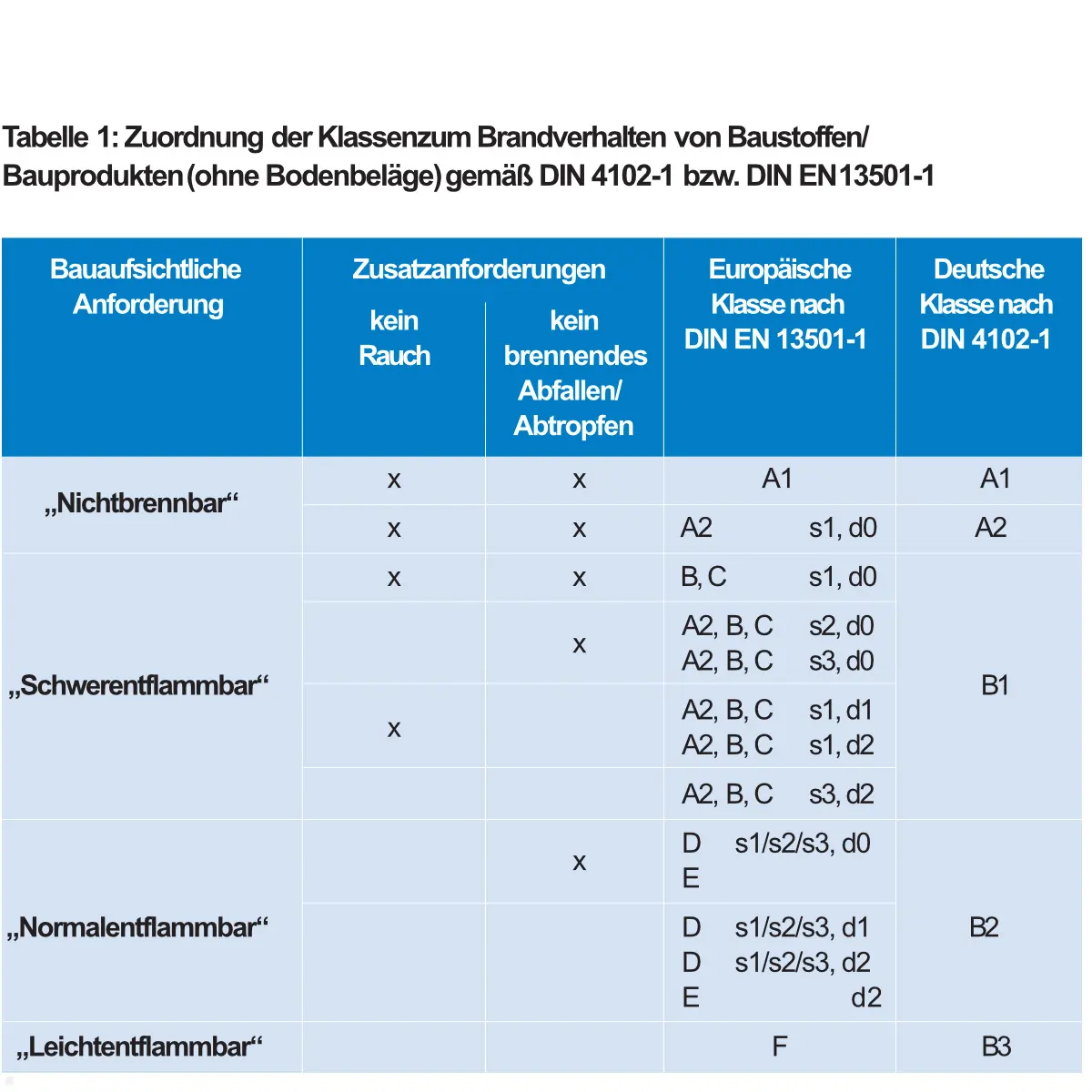Fire protection monitors in escape routes & rescue routes

In public buildings, such as hospitals, schools, shopping centers, stores, hotels, trade fairs, train stations, supermarkets or airports, preventive and defensive fire protection is required. Architects, engineers and construction managers must therefore observe the currently applicable fire protection regulations when planning and constructing buildings. This applies in particular to areas relevant to fire protection, such as stairwells or escape routes. They must be accessible in the event of fire and no combustible or smoke-generating materials may be used or installed. The absence of fire loads in escape routes is considered a fundamental component of building regulations. Despite this, fire loads in escape routes are probably one of the most frequently complained about deficiencies in buildings during fire safety inspections. Fire protection officers, fire protection experts or even the fire department support the creation of a fire protection concept for monitors displays and determine which requirements apply, for example, to fire protection housing or fire protection monitor (A1, A2, B1, ..).
Protection goals with regard to fire protection - §14 Model Building Code (MBO)
- The development of a fire is to be prevented.
- The spread of fire and smoke must be prevented.
- The rescue of people and animals must be made possible.
- Effective extinguishing work must be made possible.
Fire protection monitors / displays in escape routes or rescue routes
In practice, visual information systems are increasingly used as visitor guidance systems, information systems, signposts or as advertising platforms. If these greeting and presentation systems are used within escape routes, they represent significant fire loads due to their combustible and/or electronic components. If, for example, a fire occurs within a device due to technical defects or external influences, significant smoke development is to be expected without additional measures.
However, visual information systems/monitors/stelae (digital signage) can be optimized so that they can be mounted or installed within rescue and escape routes. There are three starting points for implementation:
- system with extinguishing system
- Commercial technology inside
- Equipment with object extinguishing system, which is limited to the inside of the unit in case of fire
- fire load optimized system
- Reduction of the fire load to a possible minimum (e.g. no plastic housings, shortening of cables to a minimum, installation of components and boards protected against ignition)
- Protection by own fault circuit breaker (FI)
- Verification of the level of the fire load by means of fire load determination
- encapsulated system
- Housing as tight as possible (no ventilation slots or other openings)
- No smoke escapes from the housing onto the escape route; at the same time, the inflow of oxygen is reduced
- Installation of a smoke detector
- The standard for encapsulation can be, for example, protection class 65 (dust-tight, jet-proof) according to DIN EN 60529.
Fire loads in escape routes
In individual cases, it is possible that certain fire loads may remain in escape routes. The prerequisite for this is a fire protection assessment depending on the type of escape route (e.g. necessary stairwell, necessary corridor), their number and the other fire protection-relevant infrastructure (e.g. fire alarm system). In a fire protection concept, all planned fire loads are named. Fire protection officers, fire protection experts or even the fire department can assist in the preparation.
PRIORIT - Enclosures / Protective housings for monitors
PRIODIS from PRIORIT is a safe monitor enclosure for escape and rescue routes. The enclosure is made of non-combustible material, completely encloses the monitors (LED, LCD and plasma screens up to a maximum of 40 inches) and prevents neither smoke nor fire from escaping the enclosure in case of fire. The development of fire or smoke is prevented because no oxygen can flow in. PRIODIS enclosures are in line with the encapsulated system approach.
The company offers two versions: PRIODIS Basic and PRIODIS 30. The housing of PRIODIS 30 offers additional fire resistance over 30 minutes (fire retardant). The other features are almost identical:
- Tested fire protection for monitors in escape routes
- Natural fire test
- Smoke protection
- Encapsulation of fire load
- Protection against vandalism, dust & dirt
- Non-combustible housing with easy-to-clean surface
- Brilliant, tempered safety glass provides high-contrast images from any viewing angle
- Cable entry through fire protection seal
- Easy mounting
- Horizontal and vertical mounting possible
- Building material with surface coating non-combustible, classification A2 - s1, d0
PRIODIS is the tested protection for the legally flawless use of monitors in escape and rescue routes. This is a housing that completely encloses monitors. Maximum safety for public use in schools and halls and foyers.
We support you in integrating digital signage in fire-sensitive areas. PRIORIT's monitor enclosures / monitor protective housings have been tested at the Materialprüfanstalt in Dresden (fire tests) and are fire retardant. The company is certified according to ISO 9001. Do you have any questions about monitor enclosures from PRIORIT? Feel free to contact us by phone or e-mail! All Priorit products can be purchased in the online store. These include the PRIODIS Basic and PRIODIS 30 monitor enclosures including accessories for 32-inch, 40-inch, 46-inch, 50-inch and 55-inch monitors.
Fire protection monitors from DISTEC - A1
Distec fire protection monitors comply with the highest fire protection class A1 according to DIN EN 13501-1:2019-05 and can therefore be used in escape routes and emergency exits. Fire protection class A1 certifies that the monitor / screen / TV is not combustible. This makes Distec the only supplier on the market to offer a stand-alone fire load and smoke gas optimized monitor with the highest fire protection class A1, even with multi-touch screen on request. The use of separate fire protection enclosures is not required for the monitors.
Strict fire protection regulations apply in buildings with a high volume of people as well as areas accessible to the public, such as shopping malls or museums. Anyone wishing to use digital information systems in these locations must ensure that the monitors do not pose a fire hazard. The installation of standard monitors is usually not permitted, as in the event of a fire the smoke emitted by the technical equipment could have devastating consequences in these sensitive locations.
Some questions & answers about DISTEC fire protection monitors / displays:
- Can the BLO-Line® A1 be hung tilted forward?
To comply with fire protection class A1 according to DIN EN13501-1, this monitor must be mounted directly and flat on a wall so that flames cannot reach behind the monitor in the event of a fire. - Can the BLO-Line® A1 be suspended from the ceiling?
To comply with fire protection class A1 according to DIN EN13501-1, this monitor must be mounted directly and flat on a wall so that flames cannot get behind the monitor in the event of a fire. - How is the monitor connected?
Basically, the best solution for fire protection is to place the connections behind the monitor. Power connection and Internet access are thus covered and protected by the monitor. In cases where this is not possible for structural reasons, Distec offers a cable duct option that allows the connections to be routed to the monitor from outside as well. - How long is the cable duct connection that protrudes from the housing?
The cable duct connection that protrudes from the monitor has a length of 100.5 mm and is used to connect a fireproof cable duct. The cable duct is installed over the connector on the monitor, right up to the monitor. - Does the BLO-Line® A1 have an IP classification?
The monitor is mounted flush to a wall and has no slots or openings when mounted. It is expected to achieve an IP 40 or higher rating when mounted. - Are the BLO-Line® monitors protected against vandalism?
The monitors have a robust metal housing and a 6.5 mm (with touch) or 7 mm (without touch) thick fire protection glass, so that the monitors are protected against rough external influences. Furthermore, it is protected against unintentional unhooking by two locking screws each. - Is there a WLAN interface for the BLO-Line® monitors?
For the devices with IQ and IoT solution, a WLAN or LTE stick can be optionally connected to one of the existing USB interfaces. - Can the BLO-Line® A1 monitors be protected against theft?
The monitors are protected against theft by security screws, so it is not possible to remove the monitors from the mount without further ado. - Is it possible to hang the device outdoors?
The device does not have an increased IP protection and can therefore not be hung up outdoors. - Can the cable gland be used to mount external sensors?
It is up to the customer to decide which cables can be routed through the cable gland. - On which side of the monitor is the position of the cable duct connection on the BLO-Line®?
The cable duct connection is always located on the bottom side of the monitors. The only exception is the 54.6" version. This version can also be delivered with the cable duct connection on the top side. - How high is the installation effort compared to a fire protection enclosure?
The BLO-Line® A1 is supplied complete with a wall bracket, with which the monitor is flush with the wall. This wall mount only needs to be fastened, the monitor hooked in and secured against theft with the security screws. This requires little effort, comparable to the installation of a television from the consumer sector. In the case of a fire protection enclosure, on the other hand, considerable effort is required for the installation of a monitor. This is due to the time-consuming assembly and installation of the various individual parts, some of which even have to be glued together, the much higher weight of the monitor enclosure and, of course, the fact that a monitor with a mount also has to be installed in the enclosure. - What is the difference between the BLO-Line® monitors of fire protection class A1 and the POS-Line BLO monitors of fire protection class B-s1, d0?
The BLO-Line® monitor series achieves fire protection class A1 (non-combustible, no smoke development, no burning droplets/droplets) according to DIN EN13501-1 while the POS-Line BLO monitors achieve fire protection class B-s1, d0 (hardly flammable, no smoke development and no burning droplets).
The POS-Line BLO monitors are equipped with a VESA mount. The BLO-Line® monitors require wall mounting with a wall bracket included in the delivery.
The POS-Line BLO monitors are available in sizes from 31.5" to 54.6". The BLO-Line® monitors are available in sizes from 24" to 64.5". A touch version is only available for the BLO-Line®. This is available in sizes from 24" to 54.6". An integrated eraser capsule is optionally available exclusively for the BLO-Line®.
The POS-Line BLO monitors are available with our video card PME and with an integrated IQ Atom PC. The BLO-Line® monitors are also available with our video card PME and integrated IQ Atom PC and furthermore also with our IoT solution with Raspberry Compute Module and our VideoPoster. - Which screw size can be used for the BLO-Line® wall mount?
The diameter of the holes for mounting the wall mount is 5mm for sizes 24" to 46" and 9mm for sizes 54.6" to 64.5". The customer must choose a suitable mounting depending on the nature of the wall. - From which diagonal are the monitors hinged from above or below?
The BLO-Line® monitors are hinged from the bottom from 24" up to and including 42" and hinged from the top from 46" to 64.5". More detailed information on mounting can be found in our mounting instructions, which can be found on our homepage distec.de. - Is the unit suitable for F90?
The fire resistance classes F30, F60, F90 are tested according to the previous German standard DIN4102. Here the code letter F stands for walls, ceilings, but also fire protection
Why the division into fire classes?
Fires are classified according to their burning substance. This classification is particularly necessary so that the fire department can make the appropriate selection of extinguishing agents.
Building materials are classified according to their fire behavior in building material classes.
To ensure that areas relevant to fire protection, such as stairwells or escape routes, remain accessible in the event of a fire, no combustible or smoke-generating materials, such as standard displays/monitors, may be installed or mounted in these areas. These guidelines are defined in terms of construction by the so-called fire protection classes. Accordingly, the products are adapted to these special requirements and developed accordingly. In this way, digital signage and fire protection regulations can be optimally combined.
Fire protection classes according to DIN 4102 (Germany) and EN 13501-1 (Europe) /
Assignment of the building authority designations of building materials
Roughly speaking, building materials are divided into the classes "non-combustible" (A1 and A2) and "combustible" (B1 to B3). Non-combustible building materials consist of non-flammable substances and do not themselves represent a fire load. When exposed to heat, their properties (volume, strength, etc.) can change. In contrast, combustible materials represent a fire load. They differ in their burning time (burning start) and in their fire behavior.
- Class A1 - non-combustible (no smoke emission, no burning dripping)
- Class A2 - non-combustible (proportions of combustible components, no smoke emission, no burning dripping)
- Class B1 - hardly flammable (must not continue to burn after removal of the ignition source)
- Class B2 - normal flammability (flammability must be limited with small flame)
- Class B3 - highly flammable (this concerns building materials such as paper, straw, etc.)
Smoke development (Smoke, classes s1, s2 and s3) and burning droplets (Droplets, classes d0, d1, d2) are classified as follows:
- s1: low smoke development
- s2: medium smoke development
- s3: high smoke development or smoke development not tested
- d0: no burning drip/fall within 600 seconds
- d1: no burning dripping/falling off with an afterburning time longer than 10s within 600 seconds
- d2: no power detected
Flame resistant monitors
Many manufacturers specifically offer monitors for escape routes that are B-s1, d0 rated. All adhesive tapes, plastics and other flammable parts are eliminated as much as possible during production. The monitors with fire protection are equipped with a protective glass and a metal housing. There is no corresponding standard for monitors and displays. Therefore, manufacturers have their products tested and certified according to DIN EN 13501-1 on the fire behavior of building materials. The monitors are flame-retardant, have almost no smoke development or burning dripping or falling parts in case of fire.
Special fire load optimized monitors of fire protection class A1 (non-combustible) or B-s1, d0 (flame retardant) are almost completely made of metal or fire resistant protective glass and are therefore a practical combination solution of display and fire protection housing in one for public spaces. The fire protection monitors are available in different versions with versatile functions, for example as an interactive version with touch screen.

